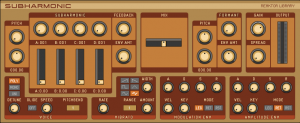
Reaktor Tutorials
Making a Simple Minimal Synth with the Reaktor SubHarmonic Ensemble
There are so many different types of minimal music now that this synth could fall into a couple categories, so call it what you will. It’s a sound that will actually do well in genres like deep house and dub tech as well. And it only takes a couple minutes to make using the Reaktor SubHarmonic ensemble! This easy to follow lesson will walk you through the set up and explain how the synth works on a basic level. So you should be bale to get started making your own sounds in no time at all!
Taking a quick look at the interface of the Reaktor SubHarmonic ensemble gives almost no idea of what the experience of designing sounds is like with this cool little synth. You probably get the urge to move sliders and turn knobs at random to figure out exactly what’s going on here. The concept is simple, even though things like this do not occur naturally in our world, we can still make them come true in the virtual world of Reaktor. It’s not a pure additive synthesis approach to making sounds, but it’s close. Although the interface itself appears to be incredibly simple to use, the underlying programming and functionality is quite complex. You can take advantage of two independent sound generators, add feedback crossfade between the two main sounds to produce beautifully layered results. Two sets of envelops control both the main amplitude and modulation, while parameters like Vibrato and Voice are able to be tweaked on a basic level. The result is actually much more powerful than you may imagine at first. And you can get all sorts of sounds that you probably wouldn’t expect from a synth like this ranging from atmospheric pads to big monophonic leads.
Here is a snapshot of the Reaktor SubHarmonic ensemble set up, as it is producing our minimal layered synth. As you can see, both sound generators are in play and through pitch, feedback and added formants the layers are set apart. The Mix slider is slightly biased towards the formant layer, so you may want to experiment with moving that to the left and see what accenting the first layer does to the sound. Both envelopes play a big part in how this sound is delivered, and are set to run in Legato mode. You can experiment with using the Re-trigger and Reset (also a Re-trigger mode) in your own sound design sessions. Adjusting the Vibrato settings can provide more movement, and really change the development over time.
This is a small audio sample of the synth in action playing alongside some drums to give you an idea of what it sounds like.
[audio:https://www.nireaktor.com/wp-content/uploads/2012/12/Reaktor-Minimal-Synth.mp3|titles=Reaktor Minimal Synth]Remember to shoot us a message before you leave if you have a tutorial request, or would like to share one of your own with the community.
Join The Conversation!
Want to ask a question about this tutorial or perhaps you have something to add to it? Click through to our forum post about this tutorial and join the conversation!
Visit MAKING A SIMPLE MINIMAL SYNTH WITH REAKTOR SUBHARMONIC
Thanks for stopping by!
Cheers,
OhmLab


 YOUTUBE
YOUTUBE